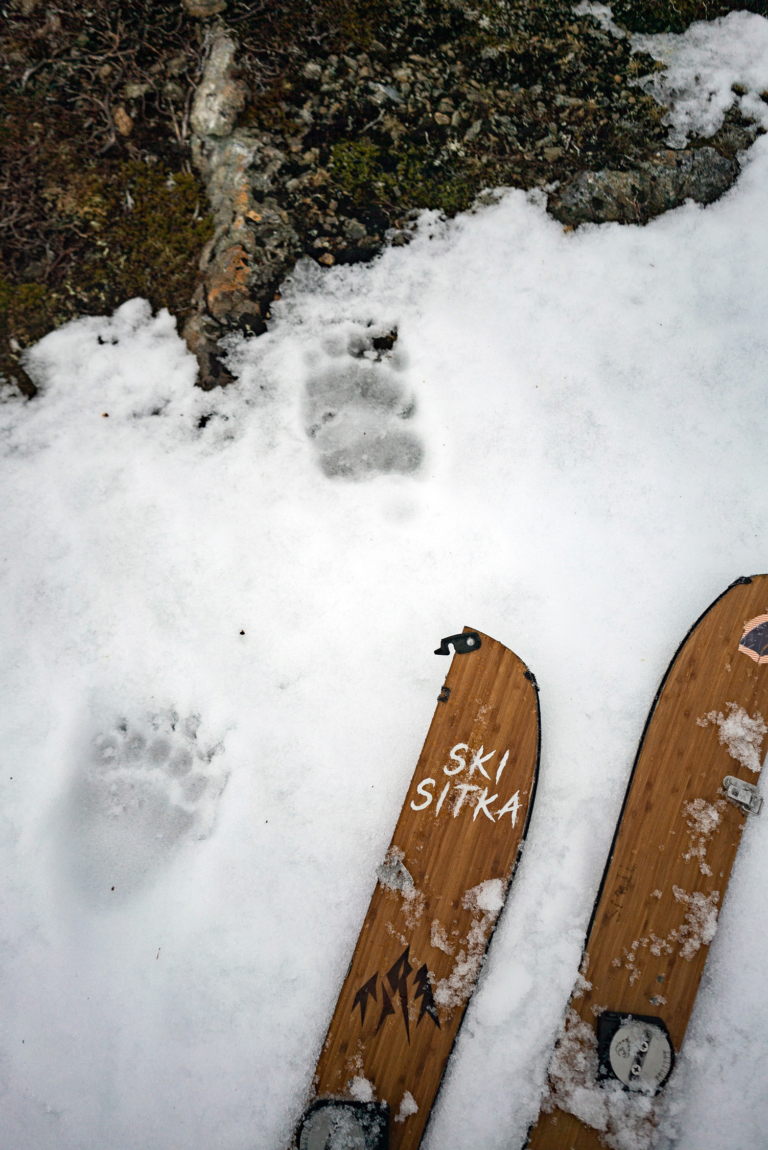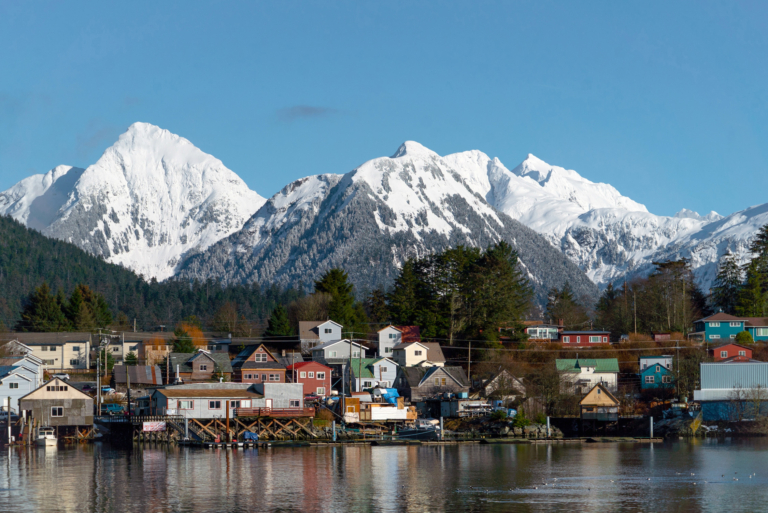A Brave, Generous Place
Observations of unraveling ecosystems from the snow-lovers of Sitka, Alaska.
“Snow in June!” I pant to Jason, as we set our packs and snowboards atop a mountain overlooking Sitka, Alaska, the small island town we call home. We’ve only had quick glimpses of the vista around us in what has otherwise been a morning shrouded in dense clouds and whisks of snowflakes. Jason checks his phone. “Weather at the airport says it’s clear and sunny down in town,” he reports. “It just needs to come a little south to us.”
I laugh and ask, “Isn’t this how it is?” A mostly cloudy forecast here is as good as a sunny day anywhere else. We’re on the outer coast of Southeast Alaska, a rainy region of ocean passages, glaciers, massive islands and vast tracts of ancient temperate rainforest.
Skiing and snowboarding in Alaska used to be all high-octane, heli-laden film segments in my mind, but in Sitka I’ve found something different. We ski and ride as friends and family, moms and dads, firefighters, search and rescue volunteers, teachers, pilots, Coast Guard members, foresters, fishermen, scientists. Some were born here, some came for a job, and others were drawn by an unshakable notion of being in a remote island community tucked on the edge of the ocean.
The snow is usually mediocre and the runs are short. A couple of thousand feet of hiking with skis on our packs gets us to the alpine. Honestly, it’s not ideal, but somehow the place anchors into our bones as we stubbornly spend our winters trudging through ice, rain and darkness to find that simple joy.

Packing skis up through the forest on the way to Picnic Rock, a classic Sitka ski destination. Photo: Lee House
I peer down the chute we are aiming to ride. It is steep but manageable. I’m contemplating how long we’re willing to wait for improved visibility when our radio bleats with an update from the rest of the group: “Hey, we just had a run-in with a bear.” We agree to regroup quickly, so Jason and I strap into our boards and make unaesthetic turns down through the fog and springtime crud. We don our skins and tour back to our friends. All that is left from the brown bear encounter are its large prints pressed freshly in the snow.
We ride, scramble and hike our way down the mountain. Snow eventually turns to scree, to alpine heather and then to the lush greens of hemlock, spruce and cedar trees. A couple of hand-lines get us through the steeps and a couple thousand more feet deposit us at sea level. On days like this, most Sitkans are out on the water fishing, but we winter-lovers continue to cling to whatever snow is left up high.

Xóots (brown bears), but more preferably their tracks, are a sign that spring has arrived in Sitka. Photo: Lee House
For me, the old flame of snowboarding rekindled when I moved to Sitka four years ago. Nearly a decade prior, I’d all but quit in the wake of staggering lift-ticket prices and the endless pressure to afford new gear. But on a hike during my first winter in Sitka, I saw a group of skiers on a distant ridge doing laps through a popular tree run. Their far-off figures quietly wove through the Sitka spruce and mountain hemlock. I couldn’t unsee it.
Through the years the pursuit of those turns has given me an intimate perspective on winters in Southeast Alaska, and their shifts. With no formal avalanche forecasting, our community of snow-lovers pays obsessive attention to the snowpack here, which tells the immediate story of the day’s snow safety conditions, but as our understandings compound, we see so much more of what is happening.
This island’s glaciers, with more exposed blue ice each year, have melted away to reveal lakes that are only as old as me. The yellow cedar trees’ root systems are left vulnerable without the insulation of longer-lasting snowpacks. The snowpack-fed salmon streams, come summer, can be too low for the fish to swim up or too hot to be hospitable. As sparse winters become more common here, the shifts in these systems do too. It seems our sliding down mountains and the snow that we depend on is connected to it all. We come out of winter caring a whole lot about home.

Mountains beckon behind Sheet’ká Kwáan (Sitka), a coastal community nestled on an island on the edge of the Pacific Ocean. Photo: Lee House
We recreate on the cusp here in Sitka. A few degrees on this Pacific Coast island is our winter-long tension between rain and snow. Like most skiers and snowboarders, my encounters with the fragility of winter leads to concern about climate change, but that is just the beginning.
The reality is that everything I could ever glean from these seasons in the mountains already exists in the deep Indigenous knowledge of generations of Tlingit, Haida and Tsimshian who have existed in this region for millennia. My understanding of place expands with each year—I am a student of my community. I live here in Sheet’ká Kwáan (Sitka) in a continuous, humble relationship with Tlingit sovereignty that, for thousands of years, has stewarded Lingít Aaní (Tlingit Country), today also known as the lungs of America or the Tongass National Forest.
Spring arrives with what the Tlingit call herring weather—erratic conditions as a prelude to the return of large schools of herring to spawn. The sun pierces through squalls of rain, hail and snow, only to open up minutes later to bright blue sky. On land, the forest slowly awakens with budding plants and bears crawling out of their dens. There is an undeniable energy that courses through the community this time of year. We ski in spring with an appetite for longer days and the budding life all around us. From the tops of peaks we watch as whales and birds feast on the large schools of herring in the bays. The coastlines froth and turn turquoise with spawn. All that lives and thrives here stems first from the herring. Their eggs are traditionally harvested by the Tlingit as the first food after winter. The salmon, with their stomachs full of herring, come next, indicating the arrival of summer.
July is known in Tlingit as Xáat disí, Salmon Month. What is left of the snow recedes quickly, flushing meltwater into the very streams the salmon follow on their spawning journeys. The landscape pulses green with the bright stippling of berries and blossoming wildflowers. We run along the mountain ridgelines and fish the ocean waters around us, filling our lungs with forest air and our bellies with fresh ocean protein. The nearly endless summer daylight eventually dissipates into autumn.

An advantageous campsite overlooking the Sitka Sound. Wake up. Make turns. Have breakfast. Make more turns. Photo: Lee House
We hunt the same forests that provide passage to spring skiing and the summer alpine. It is a slower, quieter way of moving during the fall. We watch as our shadows grow longer and the days grow colder. We watch for the first dusting of snow to creep down the peaks above Sitka.
These seasons have held space for me to learn to ask what my relationship is to the place, to the community, to the ancestral lands that I am on. I’ve begun to find the answers in sharing fish with neighbors and friends who do not have the opportunity to get out, or adding my voice to the many advocating against old-growth logging in the Tongass National Forest. When I hear Indigenous leaders say that they are witnessing a decline in the population of herring, the very foundation on which so much of Sitka’s splendor depends, I follow and stand with them by participating in the local grassroots group the Herring Protectors, who work toward Tlingit sovereignty, women’s leadership and protection against commercial overfishing of herring. Other times my answers lie simply in showing up on Saturdays to help build a healing sauna in a friend and elder’s backyard.

Squeezing another lap out of a 10 p.m. sunset in early June. Sitka, Alaska. Photo: Lee House
I didn’t come here for the snow, and I didn’t end up staying for it, either. I stayed for the community and to learn a connection to the landscape. Snowboarding has simply added to my relationship with the place. My heart is here, and for now, so is the snow.
Keep Logging Out of the Tongass National Forest
The US Forest Service and Secretary of Agriculture Sonny Perdue recently announced a final plan to eliminate Roadless Rule protections in Alaska’s Tongass National Forest, opening vast swaths of irreplaceable old-growth temperate rainforest to clear-cut logging. The Tongass is one of our largest, last remaining old-growth forests, and it is an important carbon sink for our planet.
Send a letter directly to the US Department of Agriculture (USDA) Secretary Sonny Perdue and demand he keep Roadless Rule protections on the Tongass by selecting the “no action” alternative as his final decision.

